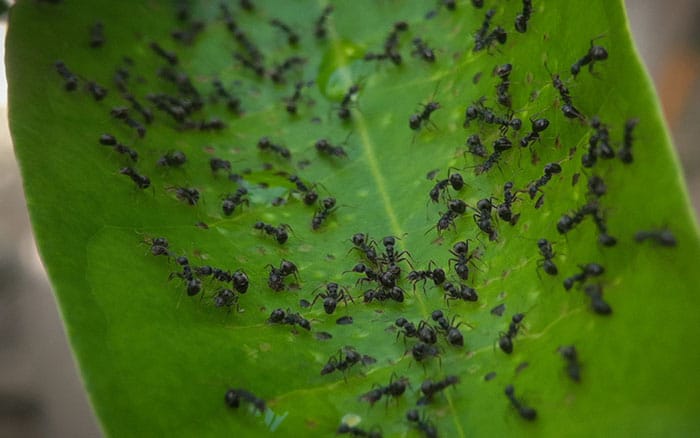Ants are an often-misunderstood creature in the garden and are part of the living landscape. Whilst they aerate the soil and help decompose organic matter, their presence can sometimes become a little too prominent.
Whether ants are nesting under paving slabs or farming aphids on your blooms, there are natural ways to limit them. Find out some of the most effective methods which don’t harm the wider ecosystem.
Ants 101: Understanding them
Most garden ants in the UK are black garden ants (Lasius niger). These clever insects build colonies in well-drained soils, especially under patios, lawn edges, or dry, compacted spots. They navigate using pheromone trails. These are chemical signals laid down by other ants to direct colony members to food and safety.
Why are they so drawn to our gardens?
- Aphids – Ants “farm” them for their honeydew, protecting them from predators.
- Dry conditions – Ideal for nest building.
- Disturbed soils – Offer easy tunnelling and warmth.
Understanding these triggers is the first step to managing them.

Control methods: Practical, proven, and pesticide-free
1 – Target the aphids first
Ants stick around when food is abundant. Aphids are a buffet.
- Biological controls: Introduce ladybirds (Coccinellidae) or lacewings. Both are voracious aphid predators.
- Soapy water spray: 1 tsp of mild soap in 1L of water strips aphids’ protective coating. Spray early morning for best results.


2 – Diatomaceous Earth (DE)
This fine powder, made from fossilised algae, is a powerhouse of pest control.
- How it works: It abrades ants’ exoskeletons, dehydrating them.
- How to use: Sprinkle around nest sites, plant bases, and entry points. Only effective when dry, so reapply after rainfall.
3 – Horticultural Nematodes
These tiny heroes (Steinernema feltiae) are invisible to the naked eye but lethal to ant larvae.
- How they work: Enter larvae and release bacteria that kill from within.
- Use: Apply in moist conditions when the soil is at least 10°C. Early morning or late evening is ideal.

Nature’s scented deterrents
Some plants naturally repel ants due to their aromatic oils.
- Mint (Mentha) – Disrupts scent trails.
- Tansy (Tanacetum vulgare) – Contains thujone, a potent repellent.
- Lavender and Pennyroyal – Strong scents that ants avoid.
Grow these around border edges, near patios or greenhouses. It’s a fragrant, fuss-free barrier.
Long-term strategy: prevention is better than a cure
Ants move in where the environment suits them. So, make it less appealing.
- Moisture control: Ants dislike damp soil. Mulch with composted bark or leaf mould to retain moisture and boost microbial life.
- Cultivate regularly: Hoeing exposes larvae and disturbs nests.
- Edge barriers: Copper tape or chalk lines at greenhouse bases or planters deter ants with sensory disruption.
By working with nature, not against it, your garden becomes not just a space of beauty, but one of balance.
For more great gardening advice, make sure you head to my YouTube Channel. Make sure you’re subscribed with notifications on so you don’t miss any of my new videos.
Frequently Asked Questions
1 – Are ants bad for my garden?
Not always. Ants aerate soil and break down organic matter, but problems arise when they nest under patios or farm aphids, which can harm your plants.
2 – What are organic ways to stop ants?
Eco-friendly options include:
- Soil disruption with a fork or hoe
- Diatomaceous Earth (DE), which dehydrates ants
- Nematodes, which target larvae
- Companion planting with mint, tansy, or lavender
3 – Why are ants attracted to my plants?
Ants are often found near aphids, which they “farm” for sugary honeydew. If you reduce aphids using soapy water or natural predators like ladybirds, ants will often move on.
4 – Which plants naturally repel ants?
Strongly scented plants such as mint, tansy, lavender, and pennyroyal naturally deter ants. Grow these near patios, borders, or greenhouses for a fragrant and functional barrier.

Leave A Comment